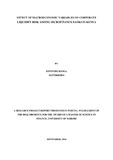| dc.description.abstract | In the last five years, macroeconomics variables have been changing in Kenya. The country have registered poor performance in most of the economic parameters as indicated by increasing interest rate, rising inflation rates, currency depreciation, and diminishing money supply in the economy. All these combined have had a negative influence on the operations and liquidity of various financial organizations especially the Microfinance institutions. Microfinance institutions are becoming increasingly vigilant to liquidity. Most of the MFI operations are managed through deposits. The objective of this study was to find out the effect of macroeconomic variables on corporate liquidity risk among microfinance banks in Kenya. This study adopted a descriptive research design. A descriptive research design describes the characteristics in a given population or a phenomenon being studied. The target population for this study comprised all Microfinance Banks in Kenya. As at 31st December 2015 there were a total of twelve (12) MFBs in Kenya. The study employed absolute secondary data to gather information relevant in conducting the study. Secondary data was collected from the Central Bank of Kenya (CBK) published reports on microfinance banks, reports by the Association of Microfinance institutions of Kenya (AMFI), Kenya Bureau of statistics (KNBS) and banking supervision reports. The quantitative data collected was then analyzed by the use of descriptive statistics. The descriptive statistical tools (SPSS Version 22 and Excel) assisted the researcher to describe the data. The findings were thereafter presented using tables and graphs. The study further used regression inferential analysis. The outcomes showed four independent variables that were studied, exchange rate and interest rate) explain a substantial 67.1% of corporate liquidity risk of MFIs as represented by adjusted R2 (0.671). The study established that the coefficient for consumer price index (CPI) was 0.321, gross domestic product (GDP) growth rate was 0.316, exchange rate was 0.397 and interest rate was 0.256. Based on the findings, the study concludes that the consumer price index (CPI), gross domestic product (GDP), growth rate, exchange rate and interest rate positively and significantly influenced the corporate liquidity risk of MFIs. This study recommends that MFIs should have sustainable liquidity risk they should embrace best practices of macroeconomic factors which will ensure that corporate liquidity is looked after in the best way possible, that adequate risk management measures are put in place and that standards are not only in writing but that they are practiced on a day to day basis. The ministry should also encourage MFIs to implement macroeconomic factors practices through enacting rules and regulations. | en_US |



